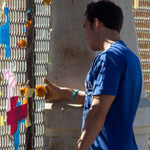Gaining new perspectives

Gaining new perspectives
- November 25, 2008
- Undergraduate class travels to U.S. Mexico border for up close and personal look at security issues
-----
 It's one thing to learn about the U.S. Mexico border - its history, security issues,
economic and political impact on relations between the two countries - in a classroom.
It's something entirely different to see it, feel it and experience it in person,
says Ricardo Chavira, veteran journalist and social science lecturer.
It's one thing to learn about the U.S. Mexico border - its history, security issues,
economic and political impact on relations between the two countries - in a classroom.
It's something entirely different to see it, feel it and experience it in person,
says Ricardo Chavira, veteran journalist and social science lecturer.
Over the last two weeks, he has taken students from his "U.S. Mexico Border Perspectives"
course down to the small restricted strip of land that separates Mexico from the U.S.
where they had the rare opportunity to interview and ride along with Border Patrol
agents and learn firsthand about security issues impacting the southern U.S. boundary.
"Few classes are so accessible to real life, tangible experiences," says Chavira who
has written about U.S. Mexico relations and border issues for Times magazine and the
Dallas Morning News for the past 30 years. "We have the opportunity to literally see
and feel what we're learning about in the classroom, and it's less than a two hour
drive away."
Upon their arrival at the U.S. Customs and Border Protection's San Diego Sector, the
students received a rundown on the history and objectives of the U.S. Border Patrol
from agent Julius Alatorre who explained the agency's role as "gaining, maintaining,
and controlling the border." He hit upon a number of key issues the students have
been studying in class, including both increased violence and cross-border drug activity
within the 7,000 square mile area under the San Diego Sector's charge, points punctuated
with official statistics showing an increase from .005 pounds of cocaine confiscated
in 2007 to 699 pounds in 2008. Marijuana confiscated by the agents was also up nearly
11,500 pounds from 37,459 in 2007 to 48,935 in 2008, according to Border Patrol statistics.
Students viewed a video highlighting the decline of mass border crossings since the
launch of the controversial Operation Gatekeeper in 1994 and learned how technology
such as night vision goggles and seismic sensors are being used to patrol more area
along the border. Students got to see firsthand a number of methods used by the agency
to stop unlawful crossings - including spike strips and the newly applied razor wire
that can be found on several stretches of the San Diego Sector border fence - before
they headed out in vans to see the fenced and barricaded area for themselves.
For some, the trip was a first and provided an eye opening experience into the real
life issues they've been learning about over the past few months. For others who have
traveled through the border in the past, the experience gave them an opportunity to
view the region from a different angle.
"It was really interesting to see the area and hear the border agents' perspectives
on violence in the region," says Kaitlin Morrow, third year social ecology major.
She vacationed in Mexico often as a child, but her family quit going when news stories
on violence in the region became more frequent. While Border Patrol statistics confirm
that violence has increased, she feels there is a human side of the story that isn't
being told. "I feel like the media and those responsible for security talk about the
violence, but don't tell the story of families struggling just to make a life." She
says she left the trip with a better perspective of the security issues the agents
at the border face, but feels that border issues encompass much more.
For Kirk Marciel, third year business economics major, and Mark Randall, fourth year
humanities major, seeing the actual fence and several different points along the way
that Border Patrol has sealed off were eye opening.
"Before going on the trip, I didn't know what I thought about a fence being the only
thing separating the U.S. and Mexico," Marciel says. "Seeing it and hearing about
how many people still try to cut through and tunnel in has given me a better perspective
on the issues we face at the border."
Randall agrees, saying he was quite surprised at the number of people who are still
attempting - and many succeeding - at crossing the border in an area as heavily secured
and patrolled as the Tijuana border. As a frequent volunteer at an orphanage across
the border in Mexico, he was glad to have the experience to see parts of the border
he's never been able to visit before and adds that he wishes more classes provided
such a unique experience.
The students, who received extra credit for taking the trip, brought their experiences
back to the classroom for those who were unable to attend through presentations of
their findings.
-----
Would you like to get more involved with the social sciences? Email us at communications@socsci.uci.edu to connect.
Share on:
Related News Items
- Careet RightNotes from a future professor
- Careet RightCan Opportunity Zones ever meet their poverty-fighting promise?
- Careet RightFei Yuan named one of ten global China Times Young Scholar Fellows
- Careet Right'Wired for Words: The Neural Architecture of Language,' an excerpt
- Careet RightEveryone's looking for a partner who has these 3 traits, according to research


